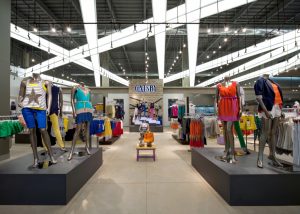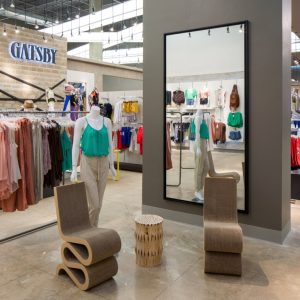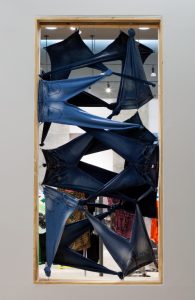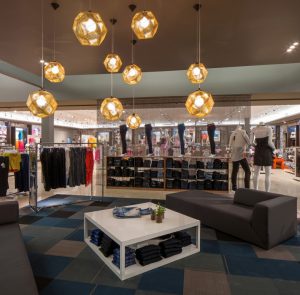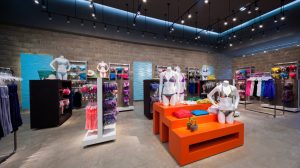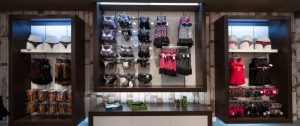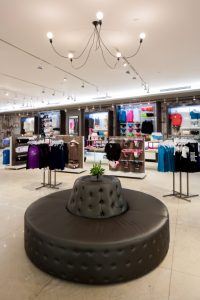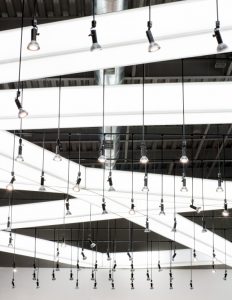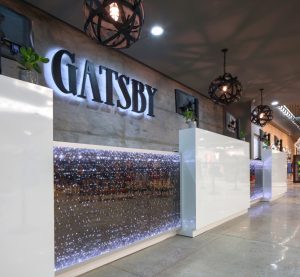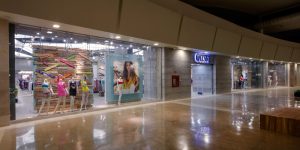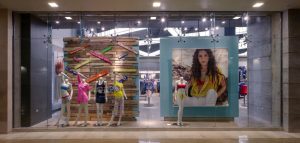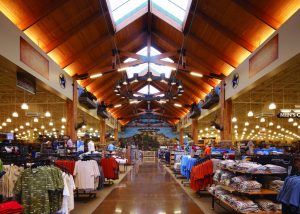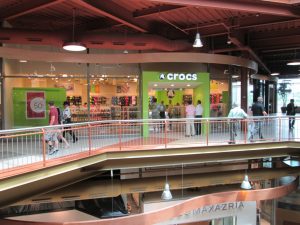Customers who visit the newly designed Gatsby store in Isla Margarita, Venezuela may be surprised to discover the store’s brightly colored ottomans were likely cut from the same kind of latex used to make gym shoes.
The ottomans made of neoprene rolls – a material used in flip-flops – were once headed to the landfills. In another area of the 16,500-square-foot store sits two rainbow-colored woven chairs. A wire frame supports discarded strips of fabric from a T-shirt factory.
Both the ottomans and chairs serve more than a functional purpose, however. It was three years ago that the family-owned company approached San Juan, Puerto Rico-based architectural and design firm Álvarez-Díaz & Villalón, seeking a new brand facelift.
At the time, Gatsby was a hybrid of 10 consignment shops in Puerto Rico and three retail stores in Venezuela. The family’s youngest and newest generation at its helm wanted a fresh start with a successful prototype to expand into new markets. It didn’t take long for their new design team to find the hook they needed.
“After our first meeting with [Gatsby], we realized they were a company that had a serious commitment to sustainability but wasn’t doing much to capitalize on it,” says Ricardo Álvarez-Díaz, president, Álvarez-Díaz & Villalón. “This was not a case of ‘green-washing.’ They believed in it and were willing to [practice] what they preached. They just needed to showcase it.”
Gatsby’s new design transformed their former vanilla box concept into a vibrant space where their eco-conscious values could be displayed. “It becomes a museum piece and provides an environment in which people want to take pictures and upload them to Facebook and Instagram and tell their friends, ‘I went to this store and look at this cool chair,’ ” Álvarez-Díaz says.
Advertisement
Gatsby’s commitment to sustainable design is a small example of what’s taking place on a global scale. “Eco-friendly” is a concept being embraced more readily by retailers that once cringed at its cost or downplayed its importance. Consumers continue to demand brands fall in line with their values and, with online shopping, they hold the power to do it.
Hurdles that once kept retailers from committing to green practices, including poor lighting and an expected low-return on investment, appear to be correcting themselves with ever-evolving materials and lower-cost options.
Still, retailers are beginning to understand their role in the bigger picture. They’re more willing to embrace that they don’t only affect the economy, but also the world’s ecology. “Retailers make sustainability a focus in their design because, number one, it’s the right thing to do,” says Brady Harding, executive director of architecture at Interbrand Design Forum in Dayton, Ohio.
Interbrand Design Forum designed a Nike Factory Store which recently opened in Rookwood Pavilion in Cincinnati. The store achieved LEED-Platinum certification simply by following its prototype specifications. “Retailers need to be good corporate citizens to set the standard for the public to understand what needs to be done for the environment,” Harding says.
SETTING THE STANDARD
On the shores of Onondaga Lake in Syracuse, N.Y., sits Destiny USA, a 2.4-million-square-foot regional shopping center that attracts more than 20 million yearly visits. More than seven years ago, the mall – originally built on a former brownfield site – broke ground on a LEED-Gold certified 1.3-million-square-foot addition. Retailers who decide to locate to the site must achieve LEED certification for their space.
“The fact that this is a requirement for a lease is pretty much unprecedented in the retail sector,” says Lauren Staniec, director of sustainability at Pyramid Management Group (Syracuse, N.Y.), which manages Destiny.
Advertisement
Staniec has a pulse on the industry when it comes to sustainability since she’s the one who helps educate and guide new Destiny tenants through the LEED process. “I don’t think there’s a reaction I haven’t seen,” she says of Destiny’s LEED requirement. Staniec walked into her role at Pyramid after working for three years with K-12 educational facilities, where sustainability was mostly a forgone conclusion. She quickly realized the same mindset didn’t translate to the retail world.
“I’ve had retailers truly embrace the project; I’ve had others who just want to get the bare minimum [complete] and others who have gone on to incorporate what they did here into all their other stores thereafter,” she says.
Charles Bertuch is a director of energy solutions at Bergmann Associates (Rochester, N.Y.). His firm obtained LEED certification for the new 2646-square-foot Crocs store that opened at Destiny late last year. The project marked Bergmann’s 100th LEED-certified project and Crocs’ first LEED-certified store. The design features a high-efficiency LED system, low-VOC construction materials and utilizes the mall’s rainwater harvest system.
Bertuch says retailers that embrace eco-friendly practices understand the impact of their decisions on a micro level, as well. Investments made in heating and air conditioning systems and LEDs may significantly impact the environment’s health while low-fume emission paints and stains may have an immediate impact on employees’ health.
“Like many, I spend most of my waking day at work,” he says. “The better the office where I am sitting, the better it is for my health and well-being.”
Destiny’s commitment to LEED meant that each construction crew had to take precautions to preserve air quality for workers and customers. “All of our centers are non-smoking, air filters used on heat pumps must meet a specific standard and certain materials that are installed must be sealed at all times until they are in place,” Staniec says.
Advertisement
REDEFINING ROI
The reason for a retailer’s hesitation to embrace green practices and design can possibly be summed up in three letters: ROI, or return on investment. Eco-friendly practices mean an increase in upfront investments with the promise of a return down the road. It might be an equation that adds up to long-term financial success for office buildings, but not necessarily a retailer where the upgrades could outlive the store.
“It’s a challenge because you’re now telling a client that they need to spend $140,000 on an air conditioning unit instead of $100,000,” Álvarez-Díaz says. “I can explain to them that they’ll make up that $40,000 in energy savings six years down the road, but the client’s response is, ‘That’s great but I may have to remodel in five.’ ”
Retailers must realize that their return on investment isn’t just seen on a utility bill. Rather, dedication to eco-friendly design can be measured in brand recognition and strong customer loyalty, according to Álvarez-Díaz.
Álvarez-Díaz says, “Customers can now go to the Internet and read about a retailer’s commitment to the environment and often that can be enough for them to determine if they will leave the house, drive to the mall and walk inside to spend their money at the store.”
It’s a balance retailers are forced to find, Álvarez-Díaz explains: constantly changing their design for an audience that wants it delivered on an eco-friendly platform.
“We are such a consumeristic culture where people want new and trendy stuff and retailers constantly need to reinvent themselves. Retailers used to have four seasons and now we have eight,” says Cristina Villalón, designer and partner at Álvarez-Díaz & Villalón. “Some of our forward-thinking clients are now taking a serious look at long-term sustainable principles, not only because it might be trendy, but because it’s good business.”
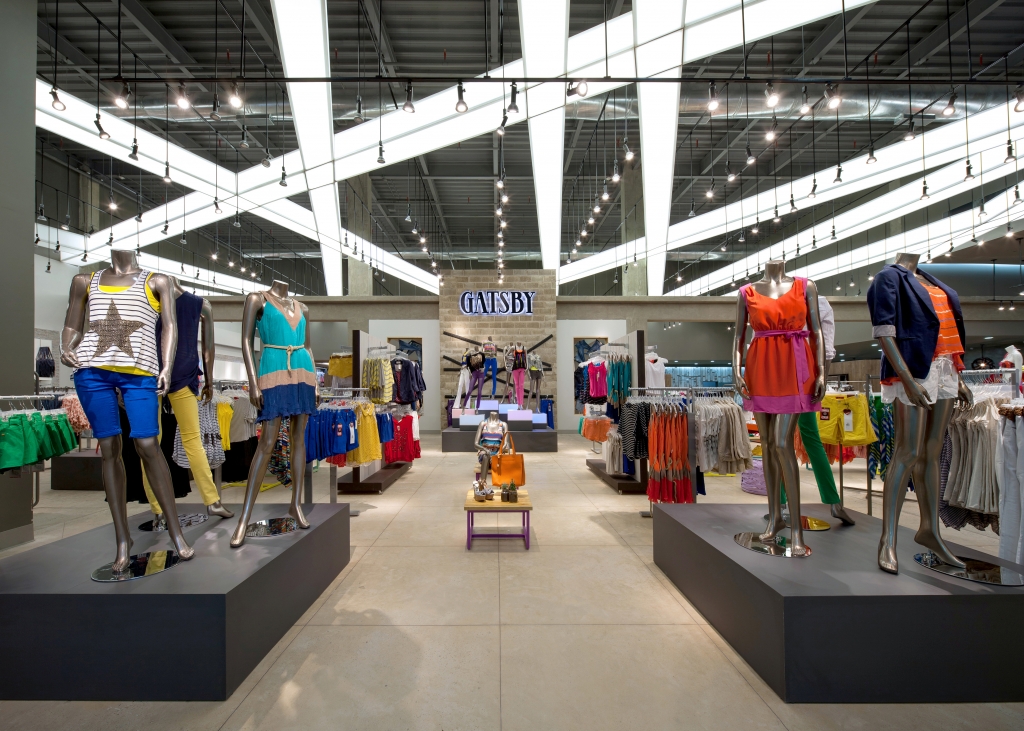

 Photo Gallery1 week ago
Photo Gallery1 week ago
 Headlines1 week ago
Headlines1 week ago
 Headlines2 days ago
Headlines2 days ago
 Headlines1 week ago
Headlines1 week ago
 Headlines1 week ago
Headlines1 week ago
 Designer Dozen2 weeks ago
Designer Dozen2 weeks ago
 Designer Dozen6 days ago
Designer Dozen6 days ago
 Headlines1 week ago
Headlines1 week ago
